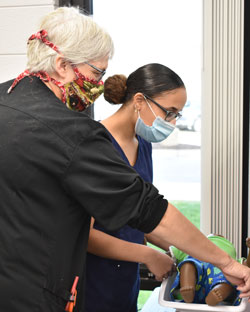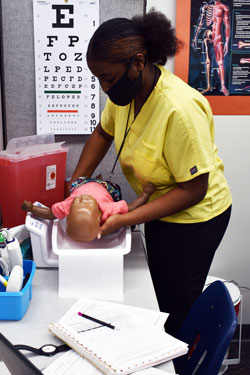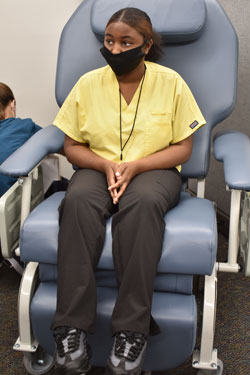Kent ISD — “Hello, my name is Heidi and I am here to take your pulse today,” says Plymouth Christian High School senior Heidi Sporte to her lab partner East Kentwood senior Gabby Cutts.
From there, Heidi begins to check Gabby’s vital signs — temperature, pulse, respiration and blood pressure. They are procedures Heidi would have to do if she was a medical assistant in a doctor’s office.

“I have really enjoyed being able to work with the actual equipment,” said Heidi, as she put a weighted baby doll on an infant scale. “It is not often you get the opportunity to get that type of hands-on learning.”
Heidi and Gabby are just two of 51 students who are part of the first Medical Assistant program at the Kent Career Technical Center. After looking at opportunities to expand its health offerings, Tech Center administrators launched the program along with an Emergency Medical Services program last fall. Juniors and seniors attend the half-day program and return to their home districts for the rest of the day.
“The expanded course offerings were a combination of wanting to meet the needs and interests of students along with the needs of the businesses and stakeholders of the community,” said Sue Gardner, Kent ISD assistant superintendent of secondary programs.
Demand in the health fields was high even before the pandemic. According to the U.S. Bureau of Labor statistics, the need for medical office assistants is expected to rise 16 percent between 2018 – 2028. Average pay for medical assistants is reported as $16.73 per hour. Growth employment opportunities for the profession is 23% — much faster than average for all occupations.

“We have seen an increase in interest in the health professions from students,” said Tech Center instructor Carolyn Blake, who leads the Medical Assistant program with instructor Christie Chapin. “At the same time, we knew we wanted to offer more opportunities to the students.”
Because of the high interest in health careers, KCTC had a waiting listing for some programs, such as its Certified Nurses Assistant program.
Unlike a CNA who works primarily with the older population, a medical assistant helps with a range of ages as he or she primarily works in a physician’s office or other outpatient facilities,, Blake said.
“For example, if a person goes to the physician’s office and has someone review their chart and talk about the visit, that might have been a medical assistant,” she said.
Students spend half the week in class and the other half in labs practicing skills such as taking a temperature, weighing and giving injections (on dummies) along with learning about the human body, what is normal and abnormal. The year-long program has been aligned with the National Healthcareer Association. Students who pass the program may then take a certification exam in May to become a certified clinical medical assistant.

A Launch Pad to Many Options
Emily Gonzalez, a senior at Potter’s House High School, hoped to pursue the Tech Center’s CNA program but with the program full, she opted for the medical assistant course instead.
“I found that I really liked it,” Gonzalez said. “You are not really sticking to any one thing, but always doing something different each week.”
She added that the diversity of people you work with also appeals to her.
The program is an entry way into many different health careers, such as CNA or nursing, Blake said. East Kentwood’s Gabby plans to use it as a stepping stone.
“My mom and sisters are kind of doing that, working in the health field, so it is something that I can see myself doing,” she said. “Being a medical assistant is one of those jobs you can do on campus, so it will be a nice way to help support myself as I go through college.”
Heidi also plans to pursue a career in health as a dental hygienist with hopes of studying at Grand Rapids Community College in the fall.
“It is helping to prepare me for what it is going to be like to work in a doctor’s office,” Heidi said.

Teaching a Hands-on Course During a Pandemic
When the state mandated all Michigan schools go virtual in November and December, students were able to maintain their learning with promising results from a practice certification test that was administered when the students came back to gauge how they are doing.
“When the programs went virtual, the Medical Assistant students didn’t miss a beat,” Blake said, adding that they got creative with skill building by sending packets of materials home and doing one-on-one skill observations.
Instructors also turn the pandemic into a learning tool, incorporating the necessary sanitization protocols for COVID in the classroom to reinforce the infection prevention and control techniques healthcare professionals encounter daily.










